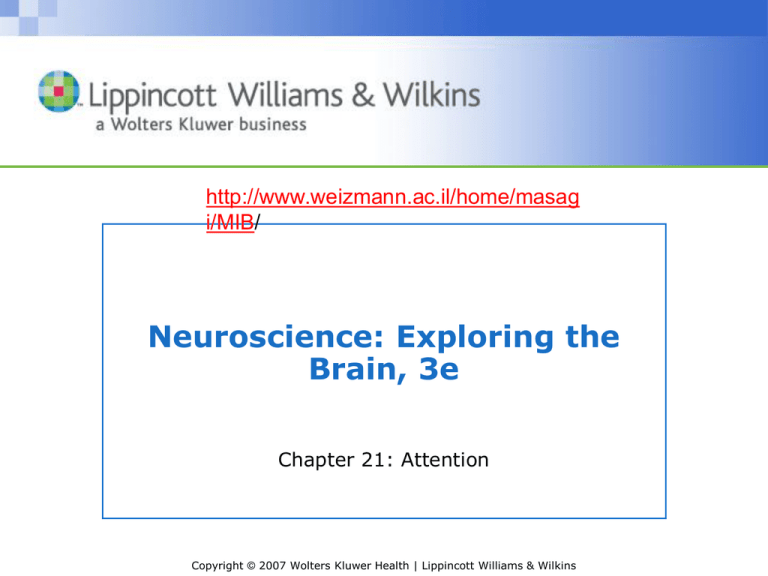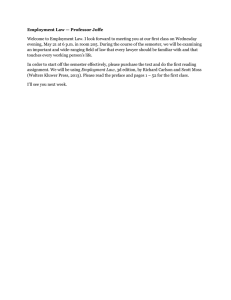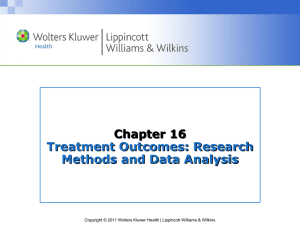Neuroscience: Exploring the Brain, 3e i/MIB
advertisement

http://www.weizmann.ac.il/home/masag i/MIB/ Neuroscience: Exploring the Brain, 3e Chapter 21: Attention Copyright © 2007 Wolters Kluwer Health | Lippincott Williams & Wilkins Introduction • Attention: • State of selectively processing simultaneous sources of information • Benefits performance of behavioral tasks • Importance emphasized by attention-deficit hyperactivity disorder • Brain Imaging – changes in cortical activity • Study attention by examining behavioral manifestations, e.g., visual attention Copyright © 2007 Wolters Kluwer Health | Lippincott Williams & Wilkins Behavioral Consequences of Attention • Attention enhances visual detection Copyright © 2007 Wolters Kluwer Health | Lippincott Williams & Wilkins Behavioral Consequences of Attention • Attention Decreases Reaction Times http://www.weizmann.ac.il/home/masag i/MIB/ Copyright © 2007 Wolters Kluwer Health | Lippincott Williams & Wilkins Physiological Effects of Attention • Shifting Attention – What happens to neural activity? – What brain areas are involved? • Observed in high-level cognitive and numerous sensory areas • e.g., Area V1 to visual cortical areas in the parietal and temporal lobes Copyright © 2007 Wolters Kluwer Health | Lippincott Williams & Wilkins Physiological Effects of Attention • Functional MRI Imaging of Attention to Location – Subjects view stimulus – Change location of attended sector – Brain activity shifts retinotopically Copyright © 2007 Wolters Kluwer Health | Lippincott Williams & Wilkins Physiological Effects of Attention • PET Imaging Attention to Features – Same-different discrimination task: Color, shape, speed – (A) Selective attention: one feature – (B) Divided attention: all features – Subtract B from A shows brain activity associated with attention to one feature V4, IT and other visual areas in temporal lobe Color & shape – Area MT Speed of motion Copyright © 2007 Wolters Kluwer Health | Lippincott Williams & Wilkins Physiological Effects of Attention • PET Imaging of Attention to Features (Cont’d) Color Shape Motion Copyright © 2007 Wolters Kluwer Health | Lippincott Williams & Wilkins Physiological Effects of Attention • Enhanced Neuronal Responses in Parietal Cortex – Attention: Experimental vs. Normal conditions – What happens to attention under normal conditions? – Assumption: Attention changes location prior to eye movement – Wurtz, Goldberg, and Robinson • Record neural activity from several brain regions Copyright © 2007 Wolters Kluwer Health | Lippincott Williams & Wilkins Physiological Effects of Attention • Enhanced Neuronal Responses in Parietal Cortex – Wurtz, Goldberg, and Robinson • Implications of Superior Colliculus work for explaining these findings Copyright © 2007 Wolters Kluwer Health | Lippincott Williams & Wilkins Physiological Effects of Attention • Enhanced Neuronal Responses in Parietal Cortex (Cont’d) – Posterior parietal cortex neurons – Directing eye movements – Response significantly enhanced neuronal response when eyes went to target • Spatially selective effect – not a general increase in excitability Copyright © 2007 Wolters Kluwer Health | Lippincott Williams & Wilkins Physiological Effects of Attention • Receptive Field Changes in Area V4 (Response to effective stim. But attention directed at location of ineffective stim.) Copyright © 2007 Wolters Kluwer Health | Lippincott Williams & Wilkins How is Attention Directed? • Cortical, subcortical areas – Modulate the activity of neurons in sensory cortex areas • The Pulvinar Nucleus – Guiding attention – Muscimol • GABA agonist • Neuron activity suppressed Copyright © 2007 Wolters Kluwer Health | Lippincott Williams & Wilkins How is Attention Directed? • Attention and Eye Movements – Eye moves to attended object – Eye movements & attention closely related – Recent experiments • Brain circuitry: Directing eyes to objects of interest – Frontal Eye Fields (FEF) • Cortical area • FEF neurons Copyright © 2007 Wolters Kluwer Health | Lippincott Williams & Wilkins How is Attention Directed? • Attention and Eye Movements (Cont’d) – Experiment • Train monkeys to look at display of small light spots • Place electrode in FEF and determine motor field of neurons at the tip • Small electrical stimulation enhancement? – Results • FEF involved in directing attention; Enhancing visual performance • V4 activity increased Copyright © 2007 Wolters Kluwer Health | Lippincott Williams & Wilkins How is Attention Directed? • Attention and Eye Movements – Results (Cont’d) • FEF stimulation mimics physiological and behavioral effects of attention • Electrical stimulation of superior colliculus – Conclusion • Guidance of attention • Integrated with system to move eyes Copyright © 2007 Wolters Kluwer Health | Lippincott Williams & Wilkins Physiological Effects of Attention Copyright © 2007 Wolters Kluwer Health | Lippincott Williams & Wilkins Concluding Remarks • Studies of attention point to flexibility of the human brain • More mental energy to one location – Enhanced sensitivity & reaction time – Ignore competing stimuli – Can be seen in brain imaging studies – Effects receptive field properties • Why do we need attention? – Cannot process all information simultaneously – Selects what information should access the limited processing resources Copyright © 2007 Wolters Kluwer Health | Lippincott Williams & Wilkins End of Presentation Copyright © 2007 Wolters Kluwer Health | Lippincott Williams & Wilkins Behavioral Consequences of Attention • Neglect Syndrome as an Attentional Disorder – Person ignores objects, people, and their own body to one side of the center of the gaze – Associated with right-sided lesions – Hypothesis: Left hemisphere attends to right hemifield whereas right hemisphere attends to both right and left hemifields Copyright © 2007 Wolters Kluwer Health | Lippincott Williams & Wilkins






